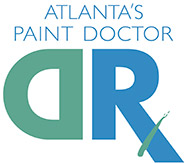Wallpaper’s popularity is cyclical, and over the decades, certain patterns and textures have gained and waned in favor. Today, however, wallpaper – or wall coverings – has returned as a viable option for adding style, color and character to our homes.
As with any wall treatment, wallpaper has a shelf life, and eventually you’ll notice its original quality fading. Having heard the horror stories that accompany steaming, stripping and removing wallpaper, many homeowners entertain the idea of simply painting over it. Is this wise? Is it even an option? If so, what are the pros and cons?
Most professional painters recommend against it because the negatives definitely outweigh the positives, especially if you take a DIY approach and don’t have a clear understanding of the proper process painting over wallpaper entails. However, if done correctly, it can be an option – as long as certain criteria are in place.
If you’re considering painting over wallpaper, explore these disadvantages and advantages first. If you’re still wary, don’t hesitate to contact a professional painter for further recommendations and advice.
ADVANTAGES OF PAINTING OVER WALLPAPER
Surely the biggest advantage of painting over wallpaper is the fact that it can save you a lot of time. If the wall covering has been in place for many years, removing it can be tedious and damage the wall beneath, ultimately leading to additional plaster and priming work.
If the wallpaper is in good condition, however, painting over it can be a viable option. Of course, there will still be preparation, priming and minor repair work to be done first, such as cleaning the walls, removing fixtures and sealing loose seams.
DISADVANTAGES OF PAINTING OVER WALLPAPER
The disadvantages of painting over wallpaper far outnumber the advantages. First, wallpaper tends to collect grease, dust and grime buildup. It also pulls away from the wall over time, especially at the corners and seams. This requires substantial repair and preparation before you can ready the wall for a fresh coat of paint. If you don’t complete these repairs diligently, your new coat of paint will be less than desirable.
Did you use an oil based primer on the wallpaper? Did you properly apply some type of wallboard material over the seams? If not, expect your latex paint to compromise and soften the wallpaper, leading to unsightly bubbling, and it won’t be long before you see the seams loosening and cracking through your fresh paint.
Also, even if you don’t realize it at first, most wallpaper has some sort of slight texture. It’s difficult to ensure this doesn’t show through – the same goes for patterns and dark colors.
Unless done knowledgeably and professionally, you may ultimately create more work for yourself than is necessary by painting over wallpaper. Having to go back to cover ripples, textures and patterns is time consuming and defeats the purpose of not removing the wallpaper in the first place.
If you no longer love the look of your wall covering or are considering refreshing your space with a new coat of paint, it’s recommended you seek professional advice in addition to doing your own research. After all, your home is not only an investment but a reflection of your style. Before painting over wallpaper, ensure the pros outweigh the cons and you’re fully educated on the proper process necessary for the desired end result.

